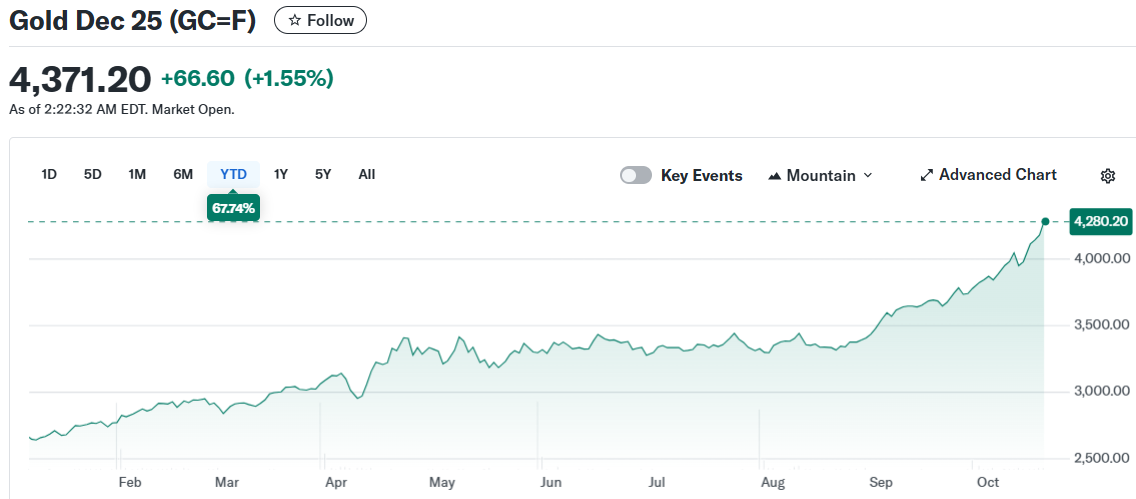TLDR
- Gold’s market capitalization hit $30 trillion as prices reached $4,357 per ounce, making it 14.5 times larger than Bitcoin’s $2.1 trillion market cap
- Gold has surged 64% since January 2025 while Bitcoin has only gained 16%, with gold up nearly 60% year-to-date compared to Bitcoin’s 13%
- Analysts predict capital will rotate from gold into Bitcoin when the gold market cools, with some calling it “the trade after the trade”
- Crypto traders are struggling with 66% of positions being short on Hyperliquid, with only 35% of traders profitable amid high leverage
- Bitcoin experienced a $19 billion deleveraging event, one of the largest in its history, with funding rates dropping to 2022 FTX-collapse levels
Gold reached a market capitalization of $30 trillion on Thursday as the precious metal hit a new all-time high of $4,357 per ounce. The milestone puts gold’s value at 14.5 times larger than Bitcoin’s current market cap of approximately $2.1 trillion.

The gold market is now 1.5 times larger than the combined market capitalization of the seven largest tech companies. Nvidia, Microsoft, Apple, Alphabet, Amazon, Meta and Tesla together total around $20 trillion in market value.
Gold has surged 64% since January 1, 2025, driven by investors seeking safety from dollar debasement, geopolitical tensions and trade tariff concerns. The precious metal has more than doubled in value since the beginning of 2024.
Bitcoin has underperformed this year with only a 16% gain from January 1 levels. The cryptocurrency currently trades almost 14% below its all-time high despite widespread expectations of a bull market.
Analysts Predict Bitcoin Rotation
Crypto analyst Sykodelic noted that gold added over $300 billion to its market cap in a single day. The analyst pointed out that gold has been adding an entire Bitcoin market cap worth of value each week.
Many market observers believe capital will flow into Bitcoin once gold’s rally slows. Venture investor Joe Consorti suggested Bitcoin could benefit if it reduces its correlation with US equities and captures gold outflows.
Analyst Merlijn the Trader observed that the M2 global money supply is rising and gold is performing well while Bitcoin remains flat. The analyst stated that this divergence typically doesn’t last long, with liquidity eventually flowing into riskier assets.
BITCOIN IS LAGGING BEHIND GLOBAL LIQUIDITY AND GOLD.
M2 is surging.
Gold is ripping.
Bitcoin is sleeping.This divergence never lasts.
Liquidity always finds risk.The catch-up rally will be brutal. pic.twitter.com/VQXAqhUUEH
— Merlijn The Trader (@MerlijnTrader) October 16, 2025
Crypto Traders Face Losses
Data from trading platform Hyperliquid shows crypto traders are positioned poorly for the current market environment. Only 34% of positions are long, with just 35% of traders showing profits.
The majority of traders are caught in losing short positions as market volatility increases. Average daily profit and loss for users has dropped to just under $50,000, indicating consistent losses.
Celebrity trader Machi Big Brother’s account dropped from $43 million in profits to over $13 million in losses. The case highlights how overleveraged bets on Bitcoin’s rebound continue to fail.
Market Deleveraging Event
Glassnode’s latest market report documented a $19 billion deleveraging event in Bitcoin markets. The research firm described it as one of the largest deleveraging events in Bitcoin’s history.
Funding rates have fallen to levels last seen during the 2022 FTX collapse. ETF inflows have turned negative, while long-term holders are selling into strength.
Glassnode warns that Bitcoin risks deeper contraction below $108,000 unless new demand emerges. The current market sits in what the firm calls a “reset phase.”
Traders on prediction market Kalshi show confidence that 2025 will be the year gold outperforms Bitcoin. Despite Bitcoin trading 13% higher year-to-date, gold’s nearly 60% gain has far exceeded cryptocurrency returns.
Gold’s rise has been driven by geopolitical tension, cooling inflation and expectations of rate cuts. Bitcoin’s speculative structure, dependent on ETF flows and derivatives leverage, has not captured the same momentum as the traditional safe-haven asset.





